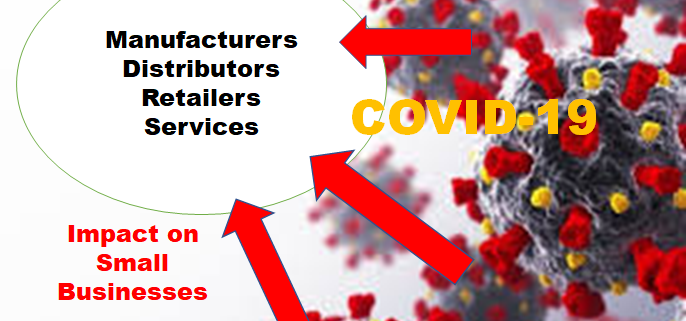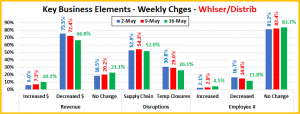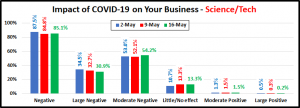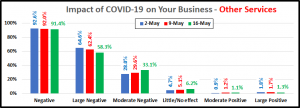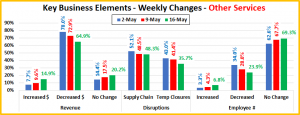U.S. Census Bureau Small Business Pulse Survey – Measuring the Impact of COVID-19
Small Businesses are at the core of our nation’s economy and the challenges they face are important to everyone. To better understand the impact of COVID -19 on these businesses, the U.S. Census Bureau is reaching out to small businesses in order to aid decision-makers in serving their urgent needs. For the Survey, the Census Bureau defines a small business as a single location business with employment between 1 and 499 and receipts of at least $1,000.
Consisting of 16 questions, this 5-minute survey reaches close to 1 million businesses split across a 9-week rotation to reduce burden and lessen survey fatigue. The survey reaches out to small businesses in every area of the U.S. Economy. The first survey was conducted between 4/26/20 and 5/2/20 and results were released on 5/14. This report includes the data from that initial survey as well as the data from the weeks ending 5/9 and 5/16. It will be presented in charts that will allow you to track the evolution of the responses as we progress through this crisis.
The results are categorized by major NAICS code classification. This report will show the National Average plus results from 5 big groups which are relevant to the pet industry:
- National Avg: Covers All Major Areas with a few Exceptions like Agricultural Production and Religious Organizations
- Product Related Groups:
- 31-33: Manufacturers – All manufacturers
- 42: Wholesalers/Distributors – Wholesalers/Distributors of any type products
- 44-45: Retail Trade – This includes everything from gas stations to Pet Stores (#453910). No restaurants
- Services Related Groups:
- 54: Professional, Scientific and Technical Services – Legal, Advertising Agencies, etc… and Vet Clinics (#541940)
- 81: Other Services – Funeral Homes, Barber Shops, Auto Repair, etc … and Pet Care Services (#812910)
Each group will have a separate section in the report which will have 3 charts showing the group’s responses to some particularly relevant questions about the impact of COVID-19.
Here are the charts and the questions that will be answered on each:
Chart #1: Impact of Covid-19 on Your Business
- Overall, how has this business been affected by the COVID-19 pandemic?
Chart #2: Key Business Elements – Weekly Changes
- In the last week, did this business have a change in operating revenues?
- In the last week, did this business have disruptions in its supply chain?
- In the last week, did this business temporarily close any of its locations for at least one day?
- In the last week, did this business have a change in the number of paid employees?
Chart #3: Government Assistance & Your Outlook For The Future
- Since 3/13, has this business requested/received financial assistance from Paycheck Protection Program (PPP)?
- Since 3/13, has this business received any financial assistance from any Federal Program?
- In your opinion, how much time will pass before this business returns to its usual level of operations?
Advance Observations (Spoiler Alert)
- The negative impact is widespread and deep across the U.S. Economy.
- Business measurements, like revenue, closures and employment are generally moving in the right direction, but… slowly.
- As we come fully to grip with the crisis, it becomes more apparent that recovery will take quite some time.
Now Let’s Look at the Details
We will start with the overall National Small Business Response Averages.
Then, we will move to the Product Related Groups and Wrap it up with Services.
At the conclusion there will be a link to download a PDF copy of the report!
NATIONAL AVERAGE
- Total Negative is down slightly. The biggest drop is in large negative as both the moderate negative and little/no effect groups move up.
- All measurements are moving steadily in the right directions. Although it is at an extremely low level, the group with an increase in revenue basically doubled in 2 weeks. Supply chain problems remain an issue and over 1/3 of the businesses still are reporting closures but this is down 20% from May 2nd. Employment is definitely slowly improving.
- ¾ of all small businesses requested help from the PPP. It is finally coming through as 89% of those that submitted a request have received funds as of 5/16. With help from numerous Government agencies, like the Small Business Association, 72% of the Small Businesses have received financial assistance.
- In terms of outlook the biggest decrease came in those expecting to return to normal in 2 to 3 months while the biggest increase came in the over 6 months group.
- Things are turning in the right direction in basically every measurement, but the movement is slow. As businesses became involved in the reality of the situation, it is becoming increasingly obvious that a return to normal will take some time.
MANUFACTURERS
- Total negative is slightly below the national average, but their evolving pattern is similar – a drop in large negative with increases in moderate negative and little/no effect. However, their Moderate negative share now ranks #1.
- Their Revenue is moving in the right direction but the gain in the number with an increase was miniscule. While their Supply chain issues are significant, they have the lowest percentage of closures for any group. The employee count is also coming together but like Revenue, the gain in the number adding personnel was small.
- 4 out 5 Manufacturers have requested PPP assistance and as of 5/16, 87% of those who applied had received funds. 77.8% of Small Manufacturers have received some Federal Financial assistance. This is the highest % of the 5 groups.
- Although there was a slight increase in those stating that their was little or no impact on their business, the biggest movement in the projections is to over 6 months, which grew from 32.4% to 38%. The 2 to 6 month group fell from 51.9% to 45.1%.
- The manufacturing segment is ultimately dependent upon retail so slowed business there will ultimately work its way up the distribution chain. This group is generally moving in the right directions but changes, especially increases tend to happen at a slower pace.
WHOLESALERS/DISTRIBUTORS
- The overall negative impact has remained stable and very high, ranked 2nd of all 5 groups. However, it is moderating slightly. Little impact is up slightly. Overall, positivity is down slightly but is still the 2nd highest, behind Retailers.
- Revenue is moving in the right direction. However, the percentage with decreased $ is the highest of all groups. Supply Chain problems are over 50% and 2nd highest, while Closures have the 2nd lowest rate. Employment remains very stable and moving towards a return to normal.
- 70% have applied for PPP assistance and 87% have received funds. However, this group has the highest percentage of businesses receiving no Federal financial assistance of any kind – 34%.
- Their outlook is also moving towards a longer recovery time. 38.6% of Distributors now believe that it will take over 6 months to return to normal, the highest percentage of any group. The size of the groups who saw little or no impact on their business and those who think they will never return to normal has stayed about equal, unlike any other industry segment.
- The recovery of Distributors is dependent upon the recovery of their retail customers. The faster the Retail Business returns, the faster the distributors gain $. The key is that they need to be ready and able to handle it.
THE RETAIL TRADE
- The overall negativity is the lowest of any group and is increasingly seen as moderate. However, the biggest reason the number is low is that 8.7% of Retailers are seeing a positive impact. Online retailers are one example.
- While the situation is still dire, Retailers are having the best results in terms revenue flow, with 22.2% having increased $. They are doing this despite having a very high rate of Supply Chain problems and Closures, although Closures are down 27% in 2 weeks. Employment is also improving, and they lead the way with 9.7% adding workers.
- Over ¾ of Retailers have applied for PPP assistance. By 5/16, 87% of those that applied had received funds. In fact, 74.5% of all Small Business retailers have received some type of financial assistance from the federal government.
- On May 2, 53% of retailers said things would be back to normal in 2 to 6 months. In 2 weeks that number has fallen to 46% and the number that think that recovery will take more than 6 months has risen to almost 35%.
- Next to the Health Care Segment, the Retail Segment is where we see the biggest visual impact of the COVID-19 pandemic. With stay at home and closures, we are seeing a huge movement to online shopping. However, that is not enough. This segment, without restaurants accounted for $5.4 trillion dollars in consumer sales in 2019. That’s a lot of ground to make up. Plus, the fate of the manufacturing and distributing segments is directly tied to Retail.
PROFESSIONAL, SCIENTIFIC and TECHNICAL SERVICES (INCLUDES VETERINARY CLINICS)
- Their initial perceived negative impact of COVID-19 was high at 87.5%, but it was still the lowest of the 5 groups. Also, many more, over 50%, believed the impact to be moderate rather than large. They also have the highest percentage saying there will be little or no impact from COVID-19 on their business.
- In terms of Revenue change they have the most consistency of any group – the highest percentage of no change, 32.9% – the lowest percentage with an increase and the second lowest percentage with a decrease. They also have faced the least amount of Supply problems as well as the lowest percentage of closures of any group dealing directly with consumers. Employment shows the highest percentage of no change while the increases/decreases are headed in the right directions.
- 71% applied for PPP and by 5/16, 91% had received their funds. In regard to overall Government aid, 69% have received Federal financial assistance. Only Distributors, at 64% had a lower number.
- Despite their stability in business elements and the fact that 1 in 9 say that COVID-19 has had little or no impact on their business, the outlook on recovery time for most has worsened. The group estimating a 2 to 6 month return to normalcy has fallen from 53% to 48%, under half. Over 1/3 now think it will take 6+ months to recover.
OTHER SERVICES (INCLUDES PET CARE SERVICES)
- At 92%, COVID-19 had the biggest negative impact on this group. It was also very severe. Although it has moderated slightly, the ratio of businesses with Large Negative over those with Moderate Negative remains at nearly 2 to 1.
- 80% of businesses reported a change in revenue in the week ending 5/16. The negative number was 65%. This was the highest among those interacting with consumers, but down significantly from the 78% peak. Those reporting increased $ is up to 14.9%, 2nd place behind Retailers. Supply Chain problems remain high and they have the highest percentage of closures. In terms of Employment, they are moving in the right direction – slowly. They are below the national average in additions, lowest of the group of 5 in “no change” and highest in the group for decreases.
- 80% have applied for PPP and as of 5/16, 86% of received funds. 74% of the group have received some Federal aid $.
- 32% of this group originally expected a return to normal in 3 month or less. The size of that optimistic group has dialed back to 26%. The mid-range 4 to 6 month group has remained steady at 27%. However, the group that projects 6+ months to recovery now represents 1 in every 3 businesses. We should also note that 1 in 11 businesses say they will never return to normal, the highest number in our group of five.
That wraps it up for the 5/16 update. If you would like a PDF copy of the report, click the button below.

